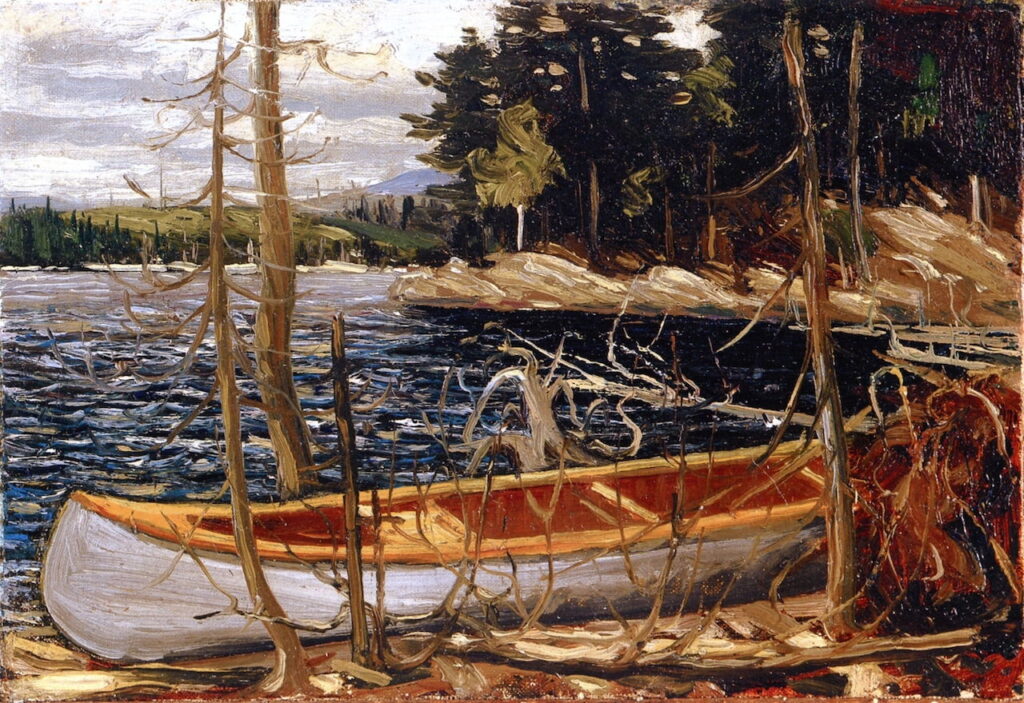A to Z of Landscapes: Kayaks and canoes

In this landscape painter’s alphabet, the letter K stands for kayaks and canoes that open access to areas that are hard to reach overland. In the nineteenth century, with the increasing popularity of painting en plein air, in front of the motif, artists used various means of taking their studio into the landscape. Among these were small boats used by Claude Monet and others. For those who wanted to travel deep into less accessible wetlands, kayaks and canoes proved both ideal means of transport and a small open-air studio.
François-Auguste Biard (1799–1882), The Duke of Orleans Riding Down the Great Rapid of Eijanpaikka at the Muonio River, Lapland, August 1795 (1840), oil on canvas, 131 × 163 cm, Château de Versailles, Versailles, France. Wikimedia Commons.
French artist-adventurer François-Auguste Biard travelled to Lappland in 1839, where he appears to have taken to the water. Following his return to the studio, he painted The Duke of Orleans Riding Down the Great Rapid of Eijanpaikka at the Muonio River, Lapland, August 1795 (1840). This shows the Duke enjoying a little white water canoeing in the far north of the Nordic countries. Biard’s depiction of the water is particularly interesting, as this predates photography.
But Biard’s exploits in canoes pale by comparison with those of an English woman, Frances Anne Hopkins, who painted her travels by water with her husband in Canada.
Frances Anne Hopkins (1838–1919), Canoe Manned by Voyageurs Passing a Waterfall (Canada) (1869), further details not known. Wikimedia Commons.
Canoe Manned by Voyageurs Passing a Waterfall (Canada) from 1869 shows a large freight canoe operated by the Hudson’s Bay Company passing a waterfall. This is presumed to be on the French River. One of the paddlers is picking water-lily flowers, which they are passing to Hopkins, who is sat next to her husband.
Frances Anne Hopkins (1838–1919), Canoes in a Fog, Lake Superior (1869), oil on canvas, 121.9 x 68.6 cm, Glenbow Museum, Calgary, Alberta, Canada. Wikimedia Commons.
Canoes in a Fog, Lake Superior from 1869 is a substantial oil painting which was Hopkins’ first work exhibited at the Royal Academy that year. Once again the artist shows herself and her husband sitting in the canoe.
Frances Anne Hopkins (1838–1919), Encampment of Voyageurs (1870), further details not known. Wikimedia Commons.
Encampment of Voyageurs from 1870 shows a couple of canoe parties camping on a small beach during a trip.
Frances Anne Hopkins (1838–1919), Shooting the Rapids (Quebec) (1879), oil on canvas, further details not known. Wikimedia Commons.
Shooting the Rapids (Quebec) from 1879 is another major oil painting of hers which was justly popular. The artist places herself in the middle of the canoe, with her husband on her left (I think).
The great exponent of painting from a canoe was the Canadian Tom Thomson, who started out in the Spring of 1912, when he made his first canoe trip in Algonquin Park, about two hundred miles out from the city of Toronto. He took with him plein air oil painting equipment, and for the next five years paddled and painted through the watery wilderness.
Tom Thomson (1877–1917), The Canoe (1912), oil on canvas, 17.3 x 25.3 cm, Art Gallery of Ontario, Toronto, ON. The Athenaeum.
Thomson’s initial oil paintings are meticulously realist, even his oil sketches such as The Canoe (1912). He was to become very familiar with paddling in open canoes like this one over the following years.
Tom Thomson (1877–1917), Old Lumber Dam, Algonquin Park (1912), oil on paperboard, 15.5 x 21.3 cm, National Gallery of Canada / Musée des beaux-arts du Canada, Ottawa, ON. The Athenaeum.
Old Lumber Dam, Algonquin Park (1912) shows a scene from his first canoeing and painting trip.
As his experience grew, Thomson took to paddling and painting from early Spring to late autumn/fall, then making finished oil paintings from those sketches during the winter in his Toronto studio.
Tom Thomson (1877–1917), Sketch for Autumn’s Garland (1915), oil on composite wood-pulp board, 21.6 x 26.7 cm, Private collection. The Athenaeum.
Sketch for Autumn’s Garland (1915) shows his innovative approach to rendering the colours of autumn.
Tom Thomson (1877–1917), Autumn’s Garland (1915-16), oil on canvas, 122.5 x 132.2 cm, National Gallery of Canada / Musée des beaux-arts du Canada, Ottawa, ON. The Athenaeum.
During the following winter, when he was back in his studio in Toronto, Thomson developed that plein air sketch into a large painting on canvas: Autumn’s Garland (1915-16). This is considerably more detailed than his original sketch, and has now lost his early fine realism, with passages containing more painterly effects and marks, such as the rocks in the foreground.
Tom Thomson (1877–1917), Boats (1916), oil on wood, 21.5 x 26.8 cm, Art Gallery of Ontario, Toronto, ON. Wikimedia Commons.
Late the following spring, Boats (1916) shows the ‘pointer’ craft used by local loggers, giving the lower half of the painting an autumnal fire to contrast with the fresh spring foliage in the band above. The exposed ground at the left and right edges is consistent with this work being painted in a pochade box of the type owned by Thomson at the time.
Tom Thomson (1877–1917), The Pointers (1916-17), oil on canvas, 101 x 114.6 cm, Hart House, University of Toronto, Toronto, ON. The Athenaeum.
The Pointers (1916-17) is a larger canvas that Thomson painted in his studio the following winter. Its title refers to the loggers’ pointer boats shown crossing this lake.
Tom Thomson (1877–1917), Tea Lake Dam (1917), oil on wood, 21.3 x 26.2 cm, McMichael Canadian Art Collection, Kleinburg, ON. The Athenaeum.
The following summer, Thomson set off to paddle to Tea Lake Dam, shown here in his vigorous sketch of this part of Algonquin Park. He was last seen on 8 July by a Park Ranger there. His body was discovered eight days later, drowned in the lake which he had paddled in and had painted so often. He was just a month short of his fortieth birthday.
Ars longa, vita brevis.
(Skilled craft takes time, but life is short.)

